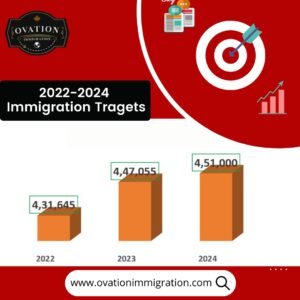Canada employs a “National Occupational Classification” (NOC) system to categorize various jobs. It is used by the Employment and Social Development Canada (ESDC) as a national referral mechanism to assess a candidate’s occupational credentials for the foreign worker and immigration programs.
Moreover, it also helps in employment forecasts and promotion of skill development through comprehensive and organized research of the Canadian labor market. NOC 0, A, B, C, or D are the occupational categories used by the prevalent NOC system.
Temporary foreign employees and skilled workers are required to establish that their work experience meets the NOC requirements of the immigration program they are applying for.
For example, the most common option for skilled workers to immigrate to Canada is through Express Entry. The candidates must show that their job experience falls under NOC skill levels 0, A, or B as one of the Express Entry eligibility criteria as candidates under skill levels C and D do not qualify.
What is The NOC 2021- TEER System?
This classification system is revised every decade in response to the changes in the Canadian labor market and the economy as a whole. These adjustments are often accompanied by substantial classification changes for restructuring of unit groups covering all skill sets.
The NOC 2021 called the TEER system is the result of such revision. Now, the Canadian Government will categorize employment activities based on the Training, Education, Experience, and Responsibilities (TEER) system wherein the entire framework of the existing occupational groups under NOC 2016 has undergone substantial structural changes.
The TEER System was unveiled on September 21st, 2021 in collaboration with Statistics Canada, which involved a rigorous in-depth assessment of occupational research and analysis of the input from stakeholders and the public in general.
However, in order to provide employers and immigration applicants enough time to transition and adapt from NOC 2016 to NOC 2021, the latter will be implemented in the second half of 2022 and will become ESDC’s official categorization. It will likely be proposed as a ministry instruction by the Canadian Government rather than through a legislative process.
What are the changes under the TEER System?
The NOC has had four skill levels up till now i.e.
| SKILL LEVEL CATEGORY | TYPICAL REQUIREMENTS |
| NOC A | Jobs that typically require a bachelor’s degree |
| NOC B | Jobs in the skilled trades or which require a college diploma |
| NOC C | Jobs requiring job-specific instruction or intermediary skill |
| NOC D | Jobs that require on-the-job training. |
The new system entails a hierarchical five-digit grouping categorization – TEER category 0, 1, 2, 3, 4 and 5. It incorporates addition, merging and splitting of new job titles into a unit group and the reorganization of the unit groups itself. Moreover, the broad groups of occupations have also been revised under the new classification structure with an addition of 16 more occupations. Here’s an overview of the TEER categories.
| TEER CATEGORY | TYPICAL REQUIREMENTS |
| TEER 0 | Jobs in Management |
| TEER 1 | A bachelor’s, master’s or doctorate; or prior experience and expertise in TEER 2 related occupation |
| TEER 2 | Post-secondary education program; or apprenticeship training program; or occupation with supervisory responsibilities; or Experience in TEER 3 related occupations. |
| TEER 3 | Post-secondary education or apprenticeship training of less than two years; or on-the-job training or job-specific experience of more than six months along with some secondary education; or experience in TEER 4 related occupation |
| TEER 4 | Secondary Education; or several weeks of on-the-job training with some secondary education; or experience in TEER 5 related occupation |
| TEER 5 | Work demonstration with no formal educational requirements |
One can also see how their current credentials correspond to the new TEER system by using the Statistics Canada Tool.
Why is the TEER system better?
The revised NOC i.e. TEER system is an overhaul of the classification’s “Skill Level” structure, besides reflecting changes in the economy as part of the review cycle. The former “skill levels” were found to be ambiguous and primarily focused on occupation rather than a candidate’s skill level.
The TEER System breaks from the orthodox low-skill and high-skill path of evaluating a candidate’s application for immigration and puts education and experience at the forefront.
Moreover, it also puts emerging fields like data sciences and cyber security into the purview of occupational categories which were missing under the former system.
What will be the effect of the TEER System on Immigration?
The buzz around the TEER System has also brought in a gush of uncertainty. It may be the case that people falling under the NOC B category with some college education or work experience may get categorized under TEER 3, 4 or 5 and may have the chances of getting eliminated for being considered for permanent residence.
However, on the other hand, it may be a possibility that people falling under the NOC C category with considerable work experience may get considered in jobs requiring more experience and skill.
The ESDC has also used NOC 2016 to examine Labour Market Impact Assessment (LMIA) applications. The LMIA is a labour market examination conducted by the Canadian government making it obligatory under the Temporary Foreign Worker Program (TFWP).
The changes under the TEER System will be crucial in LMIA and work permit requirement assessment. Employers can bring workers into the country under an LMIA.
However, they are required to advertise the vacancy using a specific NOC number. The choice of the right NOC can decide the fate of an application and the new TEER System would affect such applications for work permits.
It is presently unclear as to which TEER category would qualify for various immigration programs. A comprehensive round of consultation with immigration experts is pivotal to prevent a haphazard call of judgment under the presently foggy but potentially conducive TEER System.
Visit our office or give us a call for any questions or to get more information.




